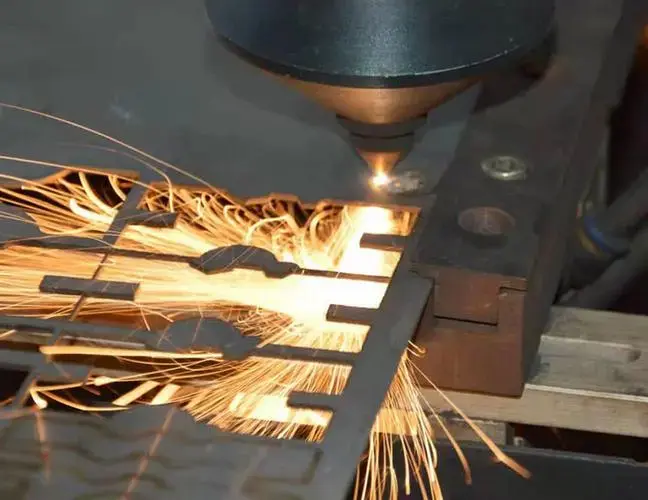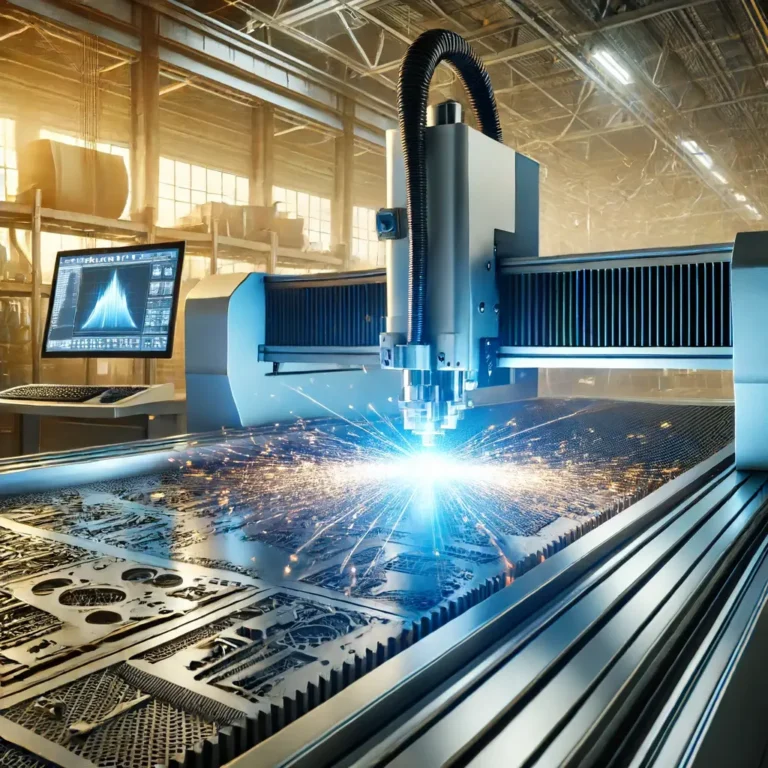Láser de corte de aluminio presenta desafíos únicos debido a su alta reflectividad y la conductividad térmica. En este blog, vamos a profundizar en los aspectos esenciales de corte por láser de aluminio, discutir los desafíos planteados por la alta reflectividad de los materiales, y explorar algunas de las innovadoras soluciones.

La comprensión de los Desafíos
La reflexión y la Absorción de
De aluminio de alta reflectividad (80%-90%) afecta de manera significativa la eficiencia de corte por láser. A diferencia de los materiales con baja reflectividad, de aluminio refleja una gran parte de el rayo láser, la reducción de la tasa de absorción. Esta baja absorción hace que sea más difícil para conseguir un corte limpio y aumenta el desgaste de los equipos de corte por láser.
La Reflexión Posterior
Una de las principales preocupaciones con el corte de alta reflectividad de los materiales como el aluminio es el daño potencial de la reflexión posterior. Cuando el rayo láser no penetre en el material, el reflejo de la luz del láser puede volver a la fuente de láser, con potencial de causar daño. Este problema requiere el uso de equipo especializado y técnicas para mitigar el riesgo.
Equipos y Técnicas para el Corte de Aluminio
1. La Luz Azul De Los Láseres
La luz azul de los láseres, operando a una longitud de onda de 400 a 500 nm, se han mostrado prometedores en el corte de la alta reflectividad de los materiales. A diferencia de los láseres de CO2 que operan en el espectro infrarrojo, la luz azul de los láseres ofrecen mejores tasas de absorción de los materiales como el cobre y el aluminio. Requieren menor potencia (de 400 a 800 vatios en comparación con el 4000 vatios necesarios para los láseres de CO2) y el resultado en menos de salpicaduras y cortes más limpios.
2. Optimizado Fibra De Salida De Los Jefes
Para abordar el problema de la reflexión posterior, algunos de corte por láser de los sistemas están equipados con la optimización de la fibra de salida de los jefes. Estas cabezas incluyen características tales como la reflexión posterior eliminación de los dispositivos de agua y sistemas de enfriamiento para proteger la fuente de láser de luz reflejada. Por ejemplo, el QBH de fibra de salida de la cabeza por Raycus Láser integra un reflejo de eliminación de un sistema para manejar la intensa reflexión de alta reflectividad de los materiales.
3. Auxiliar De Gases
El uso de los auxiliares adecuados, los gases es crucial para el logro de cortes limpios. Nitrógeno o gases inertes son los preferidos para los de aluminio para evitar la oxidación y mantener el corte de calidad. Estos gases también ayuda en la eliminación de material fundido de la zona de corte, la mejora general de la calidad de corte.
4. Pulso De Corte Por Láser
Pulso de láser de corte implica el uso de corto, de alta energía ráfagas de luz láser para cortar a través de materiales. Esta técnica es particularmente efectiva para el corte de aluminio, ya que reduce la zona afectada por el calor (HAZ) y minimiza el riesgo de que el material que se deformen. El control preciso de los pulsos del láser también ayuda en la realización de cortes más limpios y de mejor calidad en los bordes.
5. Haz Las Técnicas De Modelado De
Haz avanzado las técnicas de modelado, tales como el uso de elementos ópticos difractivos (DOE) y multi-modo de conformación del haz, puede mejorar la eficiencia de corte por láser de aluminio. Estas técnicas ayudan en la distribución de la energía del láser de manera más uniforme en todo el material, la reducción de los puntos de acceso y la mejora de la general de la calidad de corte.
6. De Alta Potencia De Los Láseres De Fibra
De alta potencia de los láseres de fibra, típicamente en el rango de 6 kW 12 kW, se han convertido cada vez más popular para el corte de aluminio con espesor de las hojas. Estos láseres ofrecen una alta eficiencia y precisión, lo que permite velocidades de corte más altas y mejor calidad en los bordes. El uso de láseres de alta potencia, también ayuda a reducir el tiempo total de procesamiento.
7. Híbrida De Láser De Corte De Los Sistemas De
Híbrida de láser de corte de los sistemas de combinar los beneficios de los diferentes tipos de láser, tales como el CO2 y el láser de fibra, para optimizar el proceso de corte para aluminio. Estos sistemas pueden cambiar entre diferentes fuentes de láser dependiendo del material y el espesor, proporcionando una mayor flexibilidad y eficiencia.
8. La Óptica Adaptativa
La tecnología de óptica adaptativa permite ajustes en tiempo real para el haz de láser, el enfoque y la forma basado en las características del material y las condiciones de corte. Esta tecnología ayuda a mantener el óptimo rendimiento de corte y la mejora de la calidad global de los recortes.
Los principales Parámetros de Corte por Láser de Aluminio
Potencia Del Láser
Escoger el derecho de potencia del láser es esencial. Mientras más energía se necesita para materiales más gruesos, el uso excesivo de energía puede conducir a la fusión y la mala calidad de corte. Es fundamental encontrar el equilibrio que se adapte el material y espesor de la deseada calidad de corte.
La Velocidad De Corte
La velocidad de corte debe ser optimizado para evitar una acumulación excesiva de calor, que puede afectar a la calidad de corte y la causa de deformaciones. En general, las velocidades más lentas de brindar una mejor calidad recortes, pero puede aumentar el tiempo de procesamiento.
El enfoque y la Calidad de la Viga
Adecuado enfoque del rayo láser es fundamental. Un pequeño punto de enfoque resulta en una mayor densidad de energía, que conduce a un mejor recortes. Asegurar que el haz del láser se centra precisamente en la superficie del material es crucial para el logro de cortes limpios.
Post-Procesamiento y Aseguramiento de la Calidad
La Eliminación De La Escoria
Después de cortar, es esencial para eliminar cualquier escoria (material residual) de los bordes para asegurar un acabado liso. Esto se puede hacer utilizando las herramientas de desbarbado o archivos.
Inspección Final
Realizar una inspección minuciosa para asegurarse de que los cortes satisfacer los requisitos de las especificaciones y estándares de calidad. Cualquier irregularidad debe ser abordado mediante el ajuste de los parámetros de corte.
Los Enfoques innovadores de Alta Reflectividad de los Materiales
La Luz Azul De Aplicaciones De Láser
La luz azul de los láseres se utilizan cada vez más en aplicaciones que requieren alta precisión y mínimo impacto térmico, tales como baterías de iones de litio y soldadura de componentes electrónicos fabricación. Su capacidad de proceso de alta reflectividad de los materiales de manera eficiente los hace una herramienta valiosa en estas industrias.
Avanzado De Fibra De Salida De Los Jefes
Mediante la incorporación de avanzados diseños en fibra de salida de los jefes, los fabricantes pueden reducir significativamente el riesgo de daño a partir de la reflexión posterior. Esta innovación permite más segura y más eficiente de procesamiento de alta reflectividad de los materiales, como el aluminio.
Conclusión
Láser de corte de aluminio requiere una cuidadosa consideración de varios factores, incluyendo la reflectividad, la potencia del láser, la velocidad de corte, y el uso de gases auxiliares. Mediante el aprovechamiento de las nuevas tecnologías como el azul de la luz láser, optimizado fibra de salida de los jefes, y haz avanzado las técnicas de modelado, es posible superar los retos y alcanzar alta calidad de los cortes. Como el corte por láser de la industria continúa evolucionando, el dominio de la corte de alta reflectividad de los materiales como el aluminio y abrirá nuevas oportunidades y aplicaciones.
